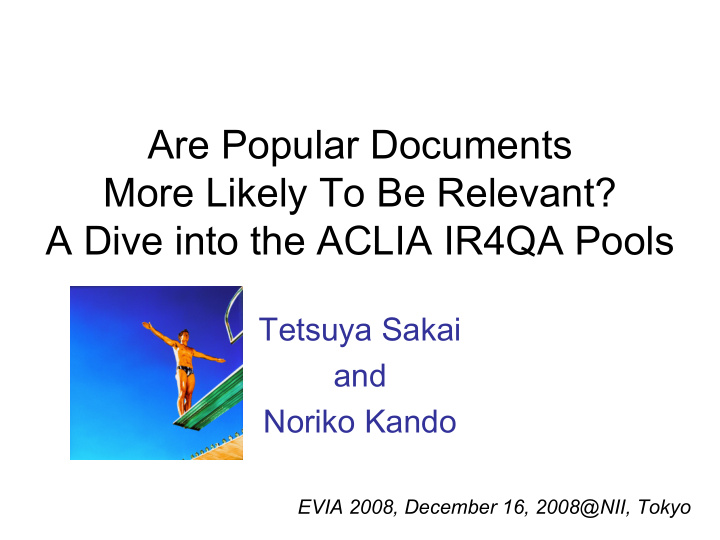



Are Popular Documents More Likely To Be Relevant? A Dive into the ACLIA IR4QA Pools Tetsuya Sakai and Noriko Kando EVIA 2008, December 16, 2008@NII, Tokyo
What is ACLIA IR4QA? • ACLIA=Advanced Cross-lingual Information Access Task Cluster • IR4QA=Information Retrieval for Question Answering Task The IR4QA test collections: - About 100 topics (CS, CT, JA and English) - 545,162 CS (Simplified Chinese) docs - 1,150,954 CT (Traditional Chinese) docs - 419,759 JA (Japanese) docs - Graded relevance assessments collected through pooling See IR4QA Overview paper for more details
Pooling for relevance assessments System 1 Pool Topic A Run 1 depth Run >= 30 depth Target =1000 Relevance Documents : assessments : L2-relevant CS: Simplified : Pool L1-relevant Chinese L0 CT: Traditional System N Chinese L2: relevant JA: Japanese Pool L1: partially relevant depth Run N Run >= 30 L0: judged depth nonrelevant =1000
Different pool depths for different topics Mandatory for all topics Assess depth-30 pool Assess depth-50 pool (minus depth-30 pool) Assess depth-70 pool (minus depth-50 pool) See IR4QA Overview Assess depth-90 pool (minus depth-70 pool) Tables 29-31 for details Assess depth-100 pool (minus depth-90 pool) Relevance assessments coordinated independently by Donghong Ji (CS), Chuan-Jie Lin (CT) and Noriko Kando (JA)
Sorting the pooled documents for assessors • Traditional approach: Docs sorted by IDs • IR4QA approach: Sort docs in depth-X pool by: - #runs containing the doc at or above rank X (primary sort key) - Sum of ranks of the doc within these runs (secondary sort key) Present ``popular’’ documents first! X=30 in this study
Assumptions behind the sort 1. Popular docs are more likely to be relevant than others. 2. If relevant docs are concentrated near the top of the list to be assessed, this is easier for the assessors to judge more efficiently and consistently . Objective of this very short talk: Show that Assumption 1 is valid for the IR4QA test collections!
Counts summed across topics Document rank in the sorted pool L0 (Judged nonrelevant) L0 increases (and eventually decreases L1 (partially relevant) due to different pool sizes across topics) L2 (relevant) L1+L2 L1+L2 is top-heavy and decreases almost monotonically; Similar pattern for L2 L1 does not necessarily follow this pattern
Counts summed across topics Document rank in the sorted pool L0 (Judged nonrelevant) L0 increases (and eventually decreases L1 (partially relevant) due to different pool sizes across topics) L2 (relevant) L1+L2 L1+L2 is top-heavy and decreases almost monotonically; Similar pattern for L2 L1 does not necessarily follow this pattern
Counts summed across topics Document rank in the sorted pool L0 (Judged nonrelevant) L0 increases (and eventually decreases L1 (partially relevant) due to different pool sizes across topics) L2 (relevant) L1+L2 L1+L2 is top-heavy and decreases almost monotonically; Similar pattern for L2 L1 does not necessarily follow this pattern
Conclusions Assumption 1: “Popular docs are more likely to be relevant than others” is correct at least for the IR4QA collections! Moreover, we observed that “Popular docs are more likely to be highly relevant than others.” So our sorting strategy may be reasonable. More on ACLIA IR4QA in the afternoon of NTCIR-7 Day 3 (18 th ) !
Recommend
More recommend